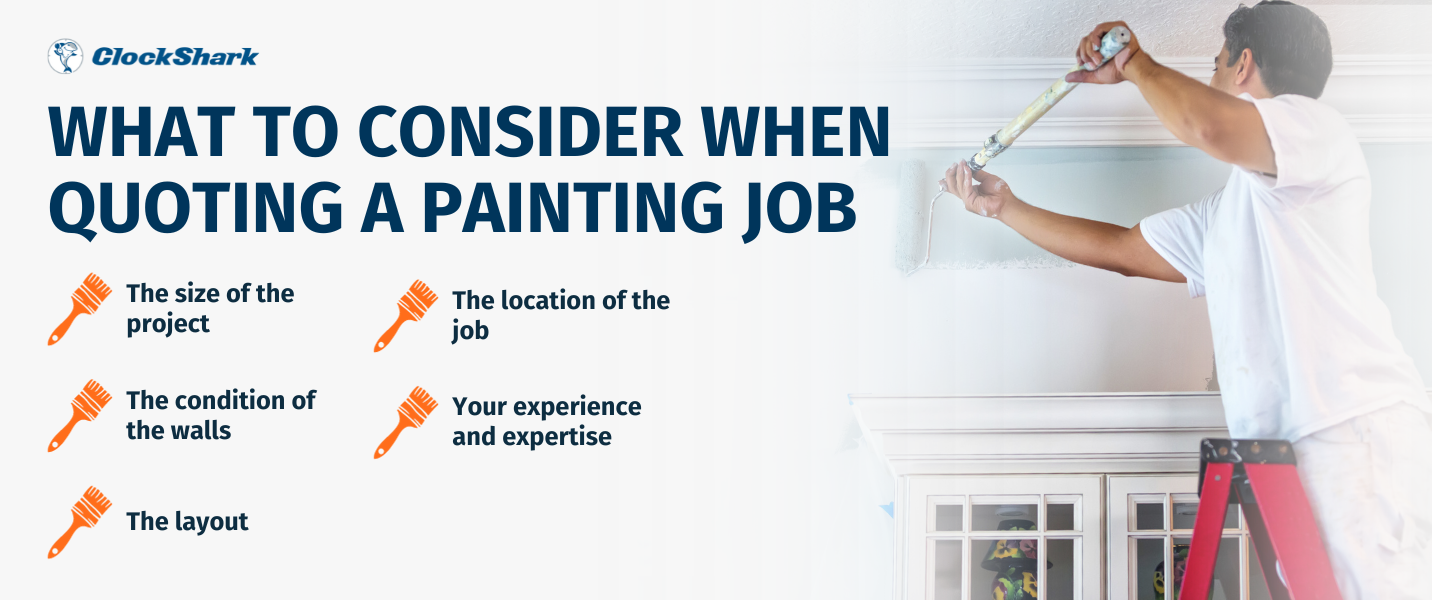Having a thorough understanding of how much to charge for painting work is essential to any painter’s profitability. Some projects can achieve an economy of scale that relies on the quantity of work, while others rely on higher profit margins, due to their smaller size.
Here we will discuss how much to charge for painting jobs using various methods, and offer practical tips for learning how to quote for a paint job that ensures profitability.
Determine your costs
Knowing how much to charge for painting a room and how much to charge for painting a house is Painting 101. However, as professional painters, you can allow your outdated quoting methods to stagnate without realizing it.
Determining how much to charge for painting work will often include a combination of strategies, depending on the project. Depending on the details of the project a professional painter might work by the hour and by the square foot on the same job.
Here are a few ways successful painting companies decide how much to charge for painting work, and when each method is commonly used:
Materials costs
Experienced painters can closely estimate how much work they can produce based on the amount of material the project will require.
This method is a quick and easy way to quote an interior, or exterior, paint job especially when similar projects have already been performed repeatedly.
However, if the estimator misses a critical obstacle that will require additional time and expense to access, profitability can be reduced significantly. This is because painting around these obstacles tends to require more labor than materials.
Labor cost plus a percentage
The cost of the labor, plus a profit percentage, is another simple method of quoting a paint job. This method guarantees profitability for the painter, but may not be as attractive to the client as a set fee or per square foot cost.
In this method, the painting company’s cost to employ the painter (including the paid wage, insurance, and taxes) added to the company’s profit margin, establishes the cost to the customer.
This method of calculating how much to charge for a painting job is also scalable, which allows the contractor to use the same method regardless of the project scope or size. This method keeps the estimate profitable but does not allow for much leeway if the project requires meeting a competitor’s price.
Overhead plus a profit margin
This option is popular with larger, more established painting companies that invest in advertising and large volume.
Painting companies large enough to have significant transportation costs, online marketing expenses, and heavy advertising costs must recover those expenses. In this strategy, the company has a specific amount of work they must perform (and collect for) to keep the business going.
For example, a painting contractor might have a target goal of 300 square feet of production every workday. The painter knows that if they paint less than 300 square feet in one day, they’ll need to make it up on another day to remain viable.
The advantage of this method is that increases in volume, above and beyond the required minimum, guarantee profitability. However, this method is vulnerable to production losses, like an unavoidable delay that disrupts cash flow.
How to estimate painting jobs
A solid understanding of how to quote interior painting jobs is the focus of many successful painting contractors. Many painting pros prefer interior painting work over exterior because the conditions are more easily controlled.
However, knowing how to quote exterior paint jobs that are both profitable and accepted is a great way to build clientele. As a result, most profitable painting companies offer both interior and exterior painting services. This allows the painter to stay working during colder parts of the year when most exterior painting projects have been postponed until spring.

To calculate a quote for a painting job, you will need to consider the following factors:
- The size of the project: The larger the project, the more time and materials will be required, and therefore the more expensive the job will be.
- The condition of the walls: If the walls are in poor condition and require a lot of preparation work, such as patching holes or cracks, you may need to charge more.
- The layout: Projects with complex layouts, such as multiple stories and winding hallways, may take longer to paint. You may need to charge a higher price for these types of jobs.
- The location of the job: Painting costs vary from region to region.
- Your experience and expertise: More experienced and skilled painters typically charge more for their services.
How much to charge for painting jobs: quoting different scenarios
Here are some examples of how you might quote different painting scenarios:
Scenario 1: How much to charge for painting a room
The cost to paint a small interior room will vary depending on many factors, including the size of the room, the type of paint used, the condition of the walls, and the location of the job. However, in general, you can expect to charge between $1.50 and $3.50 per square foot to paint a small interior room.
Some painters charge by the room instead of by the square foot because the rooms are a similar size from house to house. This method allows the painter to quote a painting job quickly since few variables could significantly affect the time and materials required.
Here is an example of how to calculate a quote for painting a small interior room:
- Room size: 10x10 feet (100 square feet)
- Paint type: Standard latex
- Wall condition: Good
- Location: Urban area
- Overhead costs: 10%
Calculation:
- Total square footage: 100 square feet
- Per-square-foot rate: $3 per square foot
- Basic estimate of the cost of the job: 100 square feet * $3 per square foot = $300
Adjustment for labor + overhead costs: $300 + ($300 * 10%) = $330
FINAL QUOTE: $330
Scenario 2: How much to charge for an exterior painting job
Exterior painting jobs also usually require more prep work, especially when the job is done on a commercial building. Traffic, pedestrians, residents, and even landscaping can become expensive to work around, so these costs must be considered.
You can generally expect to charge between $3 and $7 per square foot to paint a large exterior house.
However, it is important to note that this is just a starting point. You may need to adjust your quote up or down depending on the specific factors mentioned above. For example, if the house is in poor condition and requires a lot of preparation work, you may need to add 20-30% to your quote.
Here is an example of how to quote an exterior paint job:
- Size of the house: 2,500 square feet
- Type of paint: High-quality enamel
- Condition of the siding: Good
- Layout of the house: Simple
- Location of the job: Suburban area
- Overhead costs: $1,000
Calculation:
- Total square footage: 2,500 square feet
- Per-square-foot rate: $5 per square foot
- Basic estimate of the cost of the job: 2,500 square feet * $5 per square foot = $12,500
Adjustment for overhead costs: $12,500 + $1,000 = $13,500
FINAL QUOTE: $13,500
Scenario 3: How much to charge for interior painting job
Interior painting projects also involve common issues, such as working around wall decorations and furniture. For example, painting the trey ceiling in a master bedroom can be a challenge when a large, king-sized, four-poster bed dominates the floorplan.
You can generally expect to charge between $2 and $5 per square foot to paint a large interior house.
Here is an example of how to quote interior painting job:
- Size of the house: 3,000 square feet
- Type of paint: High-quality enamel
- Condition of the walls: Good
- Layout of the house: Simple
- Location of the job: Urban area
- Overhead costs: $1,000
Calculation:
- Total square footage: 3,000 square feet
- Per-square-foot rate: $3 per square foot
- Basic estimate of the cost of the job: 3,000 square feet * $3 per square foot = $9,000
Adjustment for overhead costs: $9,000 + $1,000 = $10,000
FINAL QUOTE: $10,000
Providing detailed and clear paint job quotes
Creating a comprehensive and accurate quote for a painting job is essential to ensure a clear understanding between you and your client and to avoid misunderstandings or disputes later on.
What to include in your quote
Regardless of how you charge for a painting job, your documentation should be complete, accurate, and timely. In modern construction, most successful painting contractors rely on technology to one degree or another for this task.
Most successful painting contractors invest in robust project management, estimating, and time-tracking software designed just for professional painters. These solutions can be integrated to work together or stand alone. These tools pay for themselves very quickly, often by catching small mistakes in the quote before it is sent to the client.
Great painting quotes and estimates will often have the same basic components. For example, a quote that is clear, easy to read, and accurate gives the client the impression the work will be done to a high standard.
A great estimate will also include details like licensing, bonding, insurance coverages, and permits when required. This gives the customer the impression they can depend on you for the details, so they can relax and enjoy the process.
Here are three elements all great quotes include:
- Detailed breakdown of costs
- Timeframe for completion
- Warranty or guarantee, if any
- payment terms
How to handle revisions and additional costs
A great estimate or quote for painting work will be designed for dealing with changes mid-job, such as change orders. Having a clearly defined process for addressing any variations to the agreement will help avoid problems later, and allow everyone a clear understanding.
Modern quoting software includes templates and other tools, which can identify inconsistencies that might result in an unnecessary change order. If changes to the project are agreed upon, these tools can generate new documentation, which can be accessed from anywhere.
Clear communication with the client should be a priority, especially when revisions and additional costs are involved. Mutual trust and respect are the cornerstones of a lifelong business relationship, so the best painting contractors aim for a win-win regardless of what changes take place.
Understanding how to charge for painting jobs
Providing accurate quotes helps painters establish trust, respect, and a fruitful relationship with their clients. Sloppy, inaccurate quotes have the opposite effect. By focusing on accuracy, transparency, and organization in your estimates, success is guaranteed.
If your quoting process is outdated and ineffective, sign up for a free trial with ClockShark. Learn how the software can help reduce your workload, prevent costly quoting mistakes, and lead to higher profits almost immediately.





